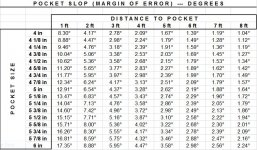You hear an awful lot on how do the pro's do it.(Aiming) What makes you think that their not doing what your doing? Are there shots you hit really well? If so, who cares how some one else does it.  If you haven't spent enough time at the table , I'm betting nothing gonna work well for you.
If you haven't spent enough time at the table , I'm betting nothing gonna work well for you.
There are no shortcuts in pocketing balls an if there was one, " IT" has a lot to do with pocketing balls an it ain't about aiming, its the stroke. (an you already new that )
(an you already new that )
Its awesome to be open minded, doesn't mean that alone will get you better. When does it stop? Some of these system are so far from what you need, its actually making the shot harder then what it really is. Now take the system you use, who made that work for you? You did, no one else.
I posted something in one of the other threads about learned perception an the the starting point is a key foundation getting it all started with not to many replies . Not to bash know one here but your arguing about peanuts when comes to how its done. (not a pro but i can make a ball..
. Not to bash know one here but your arguing about peanuts when comes to how its done. (not a pro but i can make a ball..
Stan , CJ have it right, an while i don't agree with everything thats been said about the 2 systems, they both are about perception, an they have the foundation for a good starting point.( something you can build off with feedback) I bet they spent many hours figuring out how to put it all together.
BTW I'm glad pocketing balls takes a little work, its worth it in the end. Missing isn't a failure of my aiming its my lack of learning an teaching my eyes. Paying attention to missing is just as important to making the ball, its actually the cure to make your game better.
Peace! Anthony
There are no shortcuts in pocketing balls an if there was one, " IT" has a lot to do with pocketing balls an it ain't about aiming, its the stroke.
Its awesome to be open minded, doesn't mean that alone will get you better. When does it stop? Some of these system are so far from what you need, its actually making the shot harder then what it really is. Now take the system you use, who made that work for you? You did, no one else.
I posted something in one of the other threads about learned perception an the the starting point is a key foundation getting it all started with not to many replies
Stan , CJ have it right, an while i don't agree with everything thats been said about the 2 systems, they both are about perception, an they have the foundation for a good starting point.( something you can build off with feedback) I bet they spent many hours figuring out how to put it all together.
BTW I'm glad pocketing balls takes a little work, its worth it in the end. Missing isn't a failure of my aiming its my lack of learning an teaching my eyes. Paying attention to missing is just as important to making the ball, its actually the cure to make your game better.
Peace! Anthony
